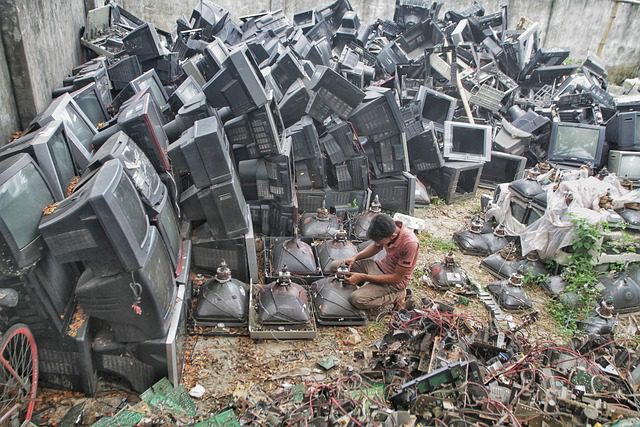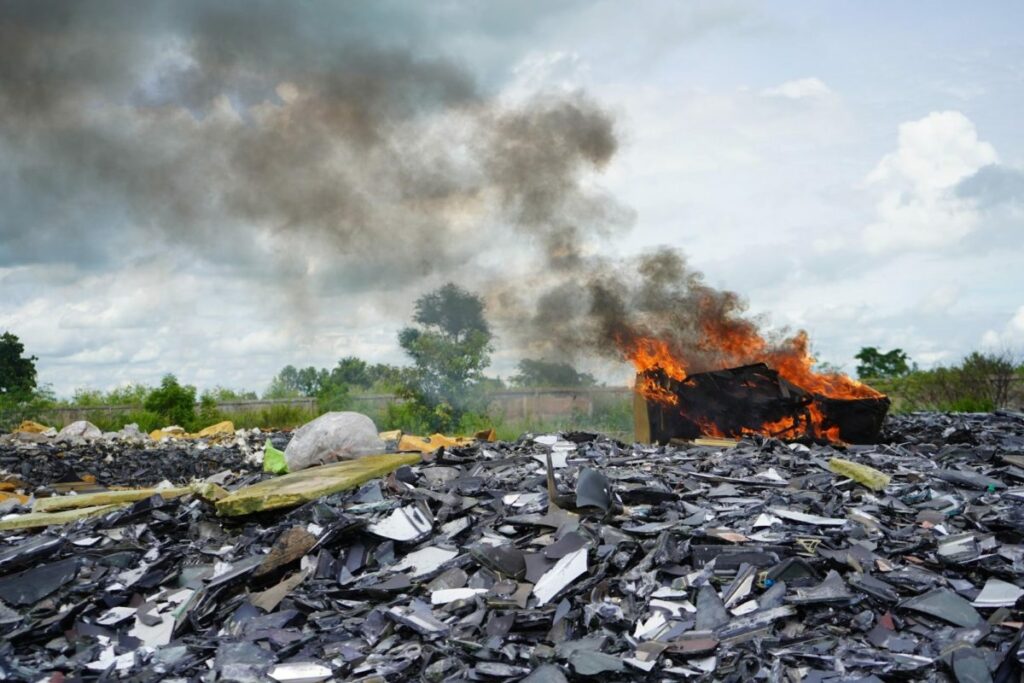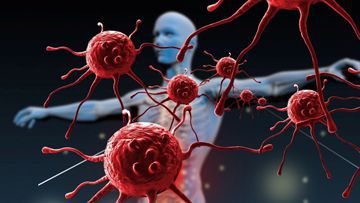“E-waste represents 2% of America’s trash in landfills, but it equals 70% of overall toxic waste,” say statistics.
Imagine you’re in a park, and a cute kitten approaches you. You want to take a picture, but your phone won’t work. You swipe, click, restart, but nothing works. It’s frozen. And by the time your camera works, the kitten is gone.
You’ve been frustrated with your phone being this way for a long time. And finally, you decide to get a new, fast and shiny one with a ton of great features.
But what are you going to do with the old one? Well, here are the options you have.
- Put it in a drawer and forget about it
- Toss it in your trash can
- Go to your nearest dumpster and put your phone where it has the recycle symbol
- Or, contact an e-waste recycling company, and discard your phone safely
Now, I think we all agree that, as a responsible citizens, the good thing to do is to dispose of your old phone safely.
But, how many of us make that effort?
And most importantly, why is this your problem? Isn’t the city or the government responsible for taking care of stuff like this? You’re simply throwing away something you don’t need like you do most of your old things.
Well, that’s what we will talk about in this post. We’ll look at e-waste and its effects in depth. And besides that, we’ll also take a closer look at your role in the problematic growth of e-waste and things you can do to alleviate it.
What is E-Waste?
E-waste or electronic waste consists of all electronic or electrical equipment you discard. Even if you donate your working old equipment to charity resellers like goodwill, there’s a chance of it ending up in the dumpster if it doesn’t sell.
Statistics show that just about 15 to 20 percent of e-waste gets recycled internationally. This number is a bit higher in the United States at 25%, but nowhere near where it should be.
When you throw away your electronic gadgets and electrical appliances, most of them end up in landfills and even get incinerated. The problem with this is when we burn e-waste,
- One, it requires a ton of valuable resources,
- And two, it releases toxic chemicals and other pollutants, causing severe damage to the environment.
E-waste Contains Toxic Substances
Most electronic and electrical appliances contain chemicals such as lead, mercury, cadmium, brominated flame retardants, beryllium, arsenic, and polyvinyl chloride. When these chemicals release into air, soil, and water, they cause:
Air Pollution
When we dispose of e-waste informally by shredding, dismantling, or melting the electronics, it releases dust particles and toxins in the air. This causes serious damage to the respiratory health of the population living near the e-waste disposal site.
Besides that, e-waste-induced air pollution can also cause people to develop chronic diseases like cancer. When you burn electronic waste, it releases fine carcinogenic particles, traveling thousands of miles through the air. So basically, you don’t even have to live near the disposal site for it to affect you.
A research group from India conducted a study to better understand the intensity of electronic waste’s informal disposal on the air and the general population.
They selected three sites based on vehicular activities, frequency of burning e-waste, and the predominance of residence. After that, they collected air samples and blood samples of the residents nearby.
Their study concluded by saying, “crude and rudimentary methods of e-waste processing by the informal sector have significantly contributed to the high levels of air particulate matter, particularly heavy metal levels, in illegal e-waste burning areas.
Chronic exposure to air pollution due to e-waste processing, in turn, was responsible for alarming levels of toxic heavy metal exposure to the local residents, which was associated with a significant prevalence of cardiovascular morbidity, namely hypertension in the local inhabitants.”
Soil Contamination
As I already mentioned, waste created from electronic gadgets and electrical appliances contains several toxins and chemicals.
A 2012 research study from China says that this kind of waste heavily contaminates the soil, causing the toxins to travel through food products like rice. And as a result, the end consumer suffers from various problems.
This study focuses on the Taizhou region of China, which has one of the largest e-waste recycling centers.
When researchers assessed Taizhou’s residents’ situation, they found that their large agricultural sector is on the verge of becoming defunct, as the e-waste sector takes precedence.
Besides that, they also found that the residents there also have a heavy dietary intake of metals through rice and vegetable. Upon testing, the researchers found that the amount of heavy metal in their blood significantly exceeded the Food and Agriculture Organization’s (FAO) guidelines.
Acidification & Toxification of Water
Waste made of electronic gadgets and electrical appliances affects water in two ways.
One, when they end up in landfills, the rainwater causes the ground to absorb the toxic chemicals, polluting the underground water reservoirs.
Two, sometimes these landfills are near rivers, ponds, and lakes, due to which the chemicals and toxins end up in the water body via rainwater. Also, most informal e-waste burners throw the remains in rivers, ending in seas and oceans.
This severely hurts freshwater, and the aquatic environment, say research studies.
E-Waste Effects on Humans
We’re a product of a sustained environment. If anything causes a disbalance in our environment, it will severely affect human health. Let’s have an in-depth look.
Damage to the Immune System
Your immune system is what defends your body against a plethora of viruses, bacteria, fungi, and toxins in our environment.
A 2019 research study found that the various materials in electronic gadgets and electrical appliances pose a significant threat to the immune system when discarded as waste.
The researchers reported that these materials are involved in the “impairment of the immune system, decreased level of immunoglobulins against viruses, defected level of CD4 and CD8 immune cells, hypersensitivity reactions, lower level of various interleukins, and lower level of NK cells formation.”
They also mentioned that children are much more vulnerable to the effects of informal e-waste disposal. And because of the involuntary exposure, they’re also much more susceptible to developing immune system-related problems like:
- Immunosuppression
- Autoimmune diseases
- Allergies
- Multiple sclerosis
- And lupus
Endocrine System
The endocrine system manages all the hormones in your body. It’s because of this system your body is able to grow, develop, rest, and reproduce.
A research study published in 2018 says that the toxins in e-waste act as an endocrine disruptor, causing many problems, including reduced ability to reproduce.
This study included Nigerian workers who were occupationally exposed to the toxins in electronic waste. The researchers concluded their study by saying:
“Nigerian e-waste workers experienced reduced levels of key gonadal hormones, and this may be associated with occupational exposure to endocrine-disrupting metals in e-waste.”
Nervous System
Studies have found that e-waste affects not only the body but also the nervous system. This is because a lot of the chemicals in electronic gadgets and electrical appliances are neurotoxic.
And experts also say that the risk of developing nervous system-related problems because of e-waste exposure is significantly high in pregnant women and young children.
DNA Damage & Cancer
DNA damage occurs when something forces your DNA to break beyond repair. See, DNA strand breaks are normal in the human body. In fact, tens of thousands of DNA strands get damaged every day. But most of the time, your cells have a way of fixing these problems.
But, when the body suffers from unnatural DNA damage, which cells cannot fix, it can result in a ton of problems, as DNA carries the blueprint for the protein in your cells to function.
If this happens, people can develop health problems like infertility, tumors, and even some forms of cancer.
A systematic review by the University of Ghana found that e-waste exposed populations have elevated levels of DNA damage biomarkers.
After review, they concluded their study, saying,:
“taken together, evidence from this systematic review with meta-analysis suggest that occupational and non-occupational exposure to e-waste processing is associated with increased risk of DNA damage measured through MN assay and other types of DNA damage biomarkers.”
And More…
These are just a few examples of how irresponsible practices with e-waste harms the general population. The World Health Organization says that this is a rapidly escalating problem. If something isn’t done about it fast, its effects can turn much more violent.
But we’re talking about millions of tons of electronic trash worldwide. So, what can you, an individual, do to stop this?
How to Reduce E-Waste?
Reducing e-waste is undoubtedly not a minor challenge. As technology grows, it incentivizes us to eliminate our old tech and replace it with newer models. And the tech you “got rid of” ends up somewhere for a while, only to violently come back at you.
See, the solution to the e-waste problem begins with you. And if you start doing your part, that’s already a huge win.
Here are some things that you can do to reduce your contribution to the growing e-waste problem.
Commit and Spread the Word
First of all, starting today, you need to commit to not treating electronic trash like regular trash. It doesn’t matter if it’s a small cell phone or a giant refrigerator. You need to ensure that you’re disposing of it properly.
If you’re in a situation where you have to get rid of your old tech, search for companies that recycle tech. Or you can also go with responsible e-waste management companies.
Do Your Research Before You Buy
Before you purchase any gadget, put some research in to ensure that it won’t get damaged shortly after you purchase it. Look for information on product durability.
One of the most common reasons people replace their tech is because of physical damages. If your tech is durable, you won’t have to change it ever so often.
Secondly, try to look for an environmentally friendly label. Tech with an Energy Star label is a good example. You can also check if the product is certified by the Electronic Product Environmental Assessment Tool.
Take Care of Your Tech
While getting a new phone, you can spend a few extra bucks to install Tempered Glass and a durable back cover. This will ensure that your gadget won’t break as easily.
For computers, make sure to clean them with virus scanners and do regular hardware checks to remove dust particles from parts like the fan and the CPU.
Also, make a habit of not over-charging your gadgets, as doing this shortens the battery’s lifespan.
Don’t Buy Gadgets You Don’t Need
This is probably one of the most important measures that you can take to limit your e-waste contribution. “Don’t buy gadgets you don’t need.”
We also often change our gadgets because of new features and applications. What I want you to do starting today is to ask yourself if you really need that new feature. Give it 24 hours. If you realize that you don’t need it, stick with your old gadget.
And if your old one is not working properly, you can give it a shot at repair. That way, you’ll accomplish two things. First, you’ll save a ton of money, and second, there will be one less electronic waste to damage our environment.
Final Thoughts
E-waste is a growing problem, and if we don’t start acting now, we’ll end up making severe changes to our environment. And if we listen to environmental experts, it will certainly not be good for us.
So, do your part and inform others about this. It’s only if we unite we can fight against this problem.












